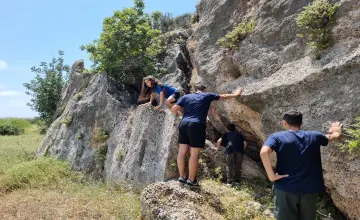The Magnificent Great Synagogue of Tel Aviv: A Must-See for Visitors and Locals
Attractions travel guideAddress: Allenby St 110, Tel Aviv-Yafo
Tel Aviv, one of the most vibrant cities in the Middle East, is home to many architectural wonders, including the Great Synagogue. Situated in the heart of Tel Aviv, this synagogue is a must-see for anyone interested in Jewish history, architecture, and culture.
The Great Synagogue of Tel Aviv, the building was designed by Yehuda Magidovitch in 1922 and completed in 1926, just a few years after the establishment of Tel Aviv as a city. It was designed by Yehuda Magidovitch, a Russian-born architect who studied in Moscow and worked in Europe before immigrating to Palestine. Magidovitch was known for his eclectic style, combining elements of Art Deco, Art Nouveau, and neo-classical architecture. His design for the Great Synagogue reflects this style, with its elegant facade, soaring dome, and intricate details.
As one approaches the Great Synagogue, the first thing that strikes the eye is the grandiose entrance. The entrance, with its towering columns and ornate decorations, is a nod to the classical architecture of ancient Greece and Rome. Above the entrance, there is a large round window that lets in light and gives the synagogue an airy feel.
Once inside the synagogue, visitors are greeted with a grand hall that is both spacious and intimate. The hall is filled with light from the large windows and the magnificent chandelier that hangs from the ceiling. The walls are decorated with murals and mosaics that depict scenes from Jewish history and tradition.
The focal point of the Great Synagogue is the Aron Kodesh, the holy ark that contains the Torah scrolls. The Aron Kodesh is located in the center of the eastern wall and is adorned with beautiful carvings and decorations. Above the Aron Kodesh, there is a large dome that is supported by pillars and decorated with intricate patterns.
The Great Synagogue of Tel Aviv is not only a place of worship but also a center of Jewish culture and community. It hosts concerts, lectures, and other events that celebrate Jewish heritage and traditions. The synagogue is also home to the Tel Aviv Museum of Jewish Art, which has a collection of Judaica and Jewish-themed art from around the world.
In conclusion, the Great Synagogue of Tel Aviv is a magnificent example of Jewish architecture and culture. Its elegant facade, grand hall, and intricate details make it a must-see for anyone interested in Jewish history and culture. Whether you are a visitor to Tel Aviv or a local resident, a visit to the Great Synagogue is sure to be a memorable experience.








